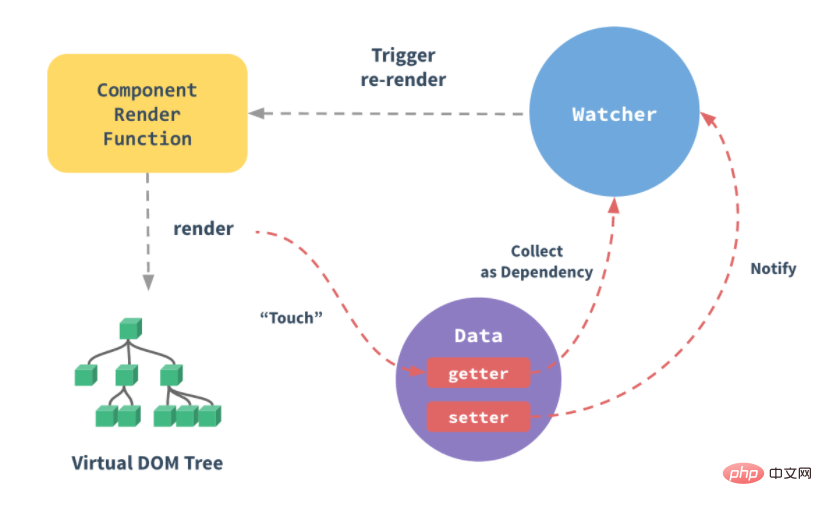Home > Article > Web Front-end > In-depth understanding of vue responsiveness principles

One of Vue’s most notable features is its less-obtrusive reactivity system. The model layer (model) is just a normal JS object, and modifying it updates the view (view). This makes state management very simple and intuitive, but it's important to understand how it works to avoid some common problems.
This article will introduce the underlying details of the Vue responsive system in detail.
Tracking changes
Pass an ordinary JS object to the data option of the Vue instance. Vue will traverse all the properties of this object and use Object.defineProperty converts all these properties into getters/setters.
Object.defineProperty is only supported by ES5 and cannot be shimmed. This is why Vue does not support IE8 browsers.
The getter/setter is not visible to the user, but internally they allow Vue to track dependencies and notify changes when properties are accessed and modified.
Each component instance has a corresponding watcher instance object. It records the properties as dependencies during component rendering, and then notifies the watcher to recalculate when the dependency's setter is called, causing its associated components to be updated.

Change Detection
Due to the limitations of modern JS (and the deprecation of Object.observe), Vue cannot The addition or deletion of an object property is detected. Since Vue will perform the getter/setter conversion process on the attribute when initializing the instance, the attribute must exist on the data object in order for Vue to convert it so that it can be responsive.
var vm = new Vue({
data:{
a:1
}
})
// `vm.a` 是响应的
vm.b = 2
// `vm.b` 是非响应的Vue does not allow dynamically adding new root-level reactive properties to already created instances. However it is possible to add response properties to nested objects using the Vue.set(object, key, value) method.
Vue.set(vm.someObject, 'b', 2)
You can also use the vm.$set instance method, which is also an alias of the global Vue.set method.
this.$set(this.someObject,'b',2)
Sometimes you want to add some attributes to an existing object, such as using the Object.assign() or _.extend() method to add attributes. However, new properties added to the object do not trigger an update. In this case, you can create a new object that contains the properties of the original object and the new properties.
// 代替 `Object.assign(this.someObject, { a: 1, b: 2 })`
this.someObject = Object.assign({}, this.someObject, { a: 1, b: 2 })Declare reactive properties
Since Vue does not allow dynamic addition of root-level reactive properties, the root level must be declared before initializing the instance Reactive properties, even just a null value.
var vm = new Vue({
data: {
// 声明 message 为一个空值字符串
message: ''
},
template: '<div>{{ message }}</div>'
})
// 之后设置 `message`
vm.message = 'Hello!'If message is not declared in the data option, Vue will warn the rendering function that the property it is trying to access does not exist.
There are technical reasons behind such a restriction. It eliminates a type of edge case in the dependency tracking system and also allows Vue instances to run more efficiently with the help of the type checking system.
And there is also an important consideration in terms of code maintainability: the data object is like a summary of the component state, and declaring all reactive properties in advance allows the component code to be re-read later or read by other developers. Easier to be understood.
Asynchronous update queue
Vue performs DOM updates asynchronously. As long as data changes are observed, Vue will open a queue and buffer all data changes that occur in the same event loop. If the same watcher is triggered multiple times, it will only be pushed into the queue once.
This kind of deduplication during buffering is very important to avoid unnecessary calculations and DOM operations. Then, on the next event loop "tick", Vue flushes the queue and performs the actual (deduplicated) work.
Vue internally tries to use native Promise.then and MutationObserver for asynchronous queues. If the execution environment does not support it, setTimeout(fn, 0) will be used instead.
For example, when setting vm.someData ='new value', the component will not re-render immediately. When the queue is flushed, the component is updated on the next "tick" when the event loop queue is cleared. In most cases, you don't need to worry about this process, but if you want to do something after the DOM state is updated, it can be a bit tricky.
Although Vue.js generally encourages developers to think in a "data-driven" way and avoid direct contact with the DOM, there are times when it is necessary to do so. In order to wait for Vue to finish updating the DOM after the data changes, you can use Vue.nextTick(callback) immediately after the data changes. This callback function will be called after the DOM update is completed.
<div id="example">{{message}}</div>var vm = new Vue({
el: '#example',
data: {
message: '123'
}
})
vm.message = 'new message' // 更改数据
vm.$el.textContent === 'new message' // false
Vue.nextTick(function () {
vm.$el.textContent === 'new message' // true
})It is particularly convenient to use the vm.$nextTick() instance method within a component because it does not require global Vue, and this in the callback function will be automatically bound to the current Vue instance:
Vue.component('example', {
template: '<span>{{ message }}</span>',
data: function () {
return {
message: '没有更新'
}
},
methods: {
updateMessage: function () {
this.message = '更新完成'
console.log(this.$el.textContent) // => '没有更新'
this.$nextTick(function () {
console.log(this.$el.textContent) // => '更新完成'
})
}
}
}) Related recommendations:
2020 Summary of front-end vue interview questions (with answers)
vue tutorial recommendations: 2020 The latest 5 vue.js video tutorial selections
For more programming-related knowledge, please visit: Introduction to Programming! !
The above is the detailed content of In-depth understanding of vue responsiveness principles. For more information, please follow other related articles on the PHP Chinese website!